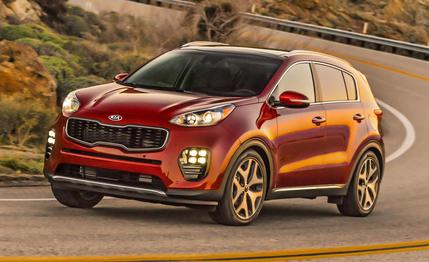
 First Drive Review
First Drive Review
After 89 years of design being an official automotive discipline, it’s probably fair to conclude that styling rates as an important factor in purchase decisions. That dates to General Motors establishing its Art and Colour Section, in 1927, and in the years since, exterior sheetmetal has either attracted or repelled a lot of buyers. But what works? Cautious? Bold? And if bold is the way to go, where’s the border between bold and weird? It’s a boundary that’s always in flux, but Kia’s redesigned Sportage seems well-conceived to explore that boundary. At least when viewed from straight on.
Leaving that cosmetic perspective aside, though, the fourth generation of this brand’s mainstay has been fortified in areas that always pay showroom dividends: interior appointments, passenger room, smooth ride, quiet operation, and contemporary safety features.
“Compact” continues to be an expanding concept in the crossover lexicon, and the latest Sportage is in step with the trend. The wheelbase has been extended by 1.2 inches to 105.1, and overall length stretches from 174.8 to 176.4. As you’d expect, this adds up to a little more room inside, particularly welcome for passengers in the outboard rear seats, who can ride comfortably with only minimal cooperation from those up front. (As in all vehicles in this class, the rear center seat is suitable only for people of diminutive dimensions or passengers who aren’t really welcome.)
The increased size also expands the cargo hold behind the rear seats by five cubic feet, to 31, although the Sportage still trails key rivals—e.g., the Ford Escape, Honda CR-V, Mazda CX-5, Toyota RAV4—in this metric. However, the volume can be increased slightly with a new provision that allows users to lower the rear load floor by about three inches. And the rear seats have been redesigned to fold flatter, making it a little easier to stow big stuff. A new auto-opening power rear hatch helps, too—just stand nearby with the key fob in your pocket.
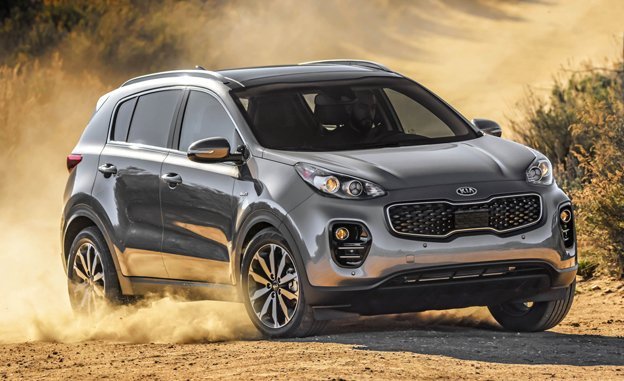

Increased dimensions, plus various interior upgrades and sound-deadening measures, also add up at the scales. Greater use of high-strength steel in the structure reduces the weight of the unibody by 55 pounds, according to Kia, but the curb weight of a fully loaded Sportage brushes up against the two-ton frontier. Our long-term 2012 Sportage SX turbo all-wheel-drive test car weighed in at 3666 pounds, 99 pounds less than Kia cites for the starting weight of the 2017 version.
More mass is never a plus in performance equations, and for the new Sportage the power side of those equations doesn’t bode well. As with the outgoing model, there are two engine choices, both four-cylinders: a naturally aspirated 2.4-liter and a 2.0-liter turbo. Both have received engineering attention to enhance efficiency. At 181 horsepower and 175 lb-ft of torque, output of the 2.4-liter four is about the same as the 2016 version. The turbo, however, sees its ratings drop from 260 horsepower to 240 (237 with all-wheel drive) and to 260 lb-ft from 269.
Kia notes that the new turbocharger spools up faster, thus summoning max torque more quickly, and the new SX Turbo—the only way to get a Sportage with the turbo engine—does seem to move out smartly from a stop. Selecting Sport mode (as distinct from Eco and Normal) alters throttle mapping and the shift points of the six-speed automatic transmission. Still, the combination of more mass and fewer ponies seems an unlikely formula for improving acceleration times, although we won’t know for sure until we’re able to subject a 2017 Sportage to instrumented testing.
On the agility scorecard, the character of this Sportage seems to differ substantially from its immediate ancestor. We dinged the previous turbo Sportage for an unforgiving ride on patchy pavement, its suspension tuning aimed at justifying the first five letters of the name. The latest Sportage seems to retreat from that objective, with a more compliant setup.
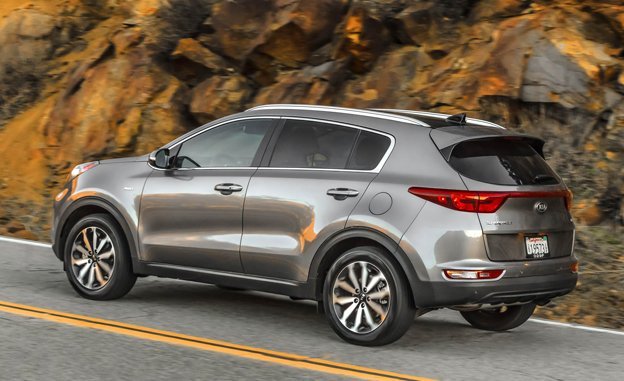

Kia fielded only SX Turbo models for its press preview, in both front- and all-wheel-drive guise. It felt very solid, a tribute to a claimed 39 percent gain in structural rigidity. Both versions were smooth operators on the rare stretches of rough going we encountered on mountain roads east of San Diego, as they absorbed freeway expansion joints and truck ruts commendably. However, none of the Sportages we drove exhibited much appetite for decreasing-radius curves, switchbacks, or ess bends. Body roll isn’t extravagant, but response to driver inputs is unhurried, particularly with all-wheel drive, which is substantially—and noticeably—heavier.
Kia’s chassis engineers have worked on the electrically assisted power steering, which is reasonably quick (2.7 turns lock-to-lock) and nicely weighted at highway speed, although still a little numb off-center. And the six-speed automatic responds to paddle commands with reasonable quickness, although it wants to upshift automatically when demand for power diminishes, regardless of operating mode, in the interest of fuel efficiency. SX Turbos are equipped with 19-inch wheels (lesser trims have 17- and 18-inchers), which should add up to improved grip.
The bottom line is a Sportage that’s not as quick on its feet. But it’s more comfortable, quiet, and composed, a trio of commendable traits.
Naturally, interior appointments contribute to the comfort quotient, and the new Sportage receives high marks. The materials wouldn’t be out of place in a vehicle wearing Lexus badges; there’s nary a hard surface anywhere, and the sporty perforated-leather seats, with heating and cooling, make the going more pleasant. Leather wraps the SX Turbo’s heated steering wheel and the shifter to add more ritz to the interior, although the wheel’s racy flat bottom is perhaps an affectation too far.
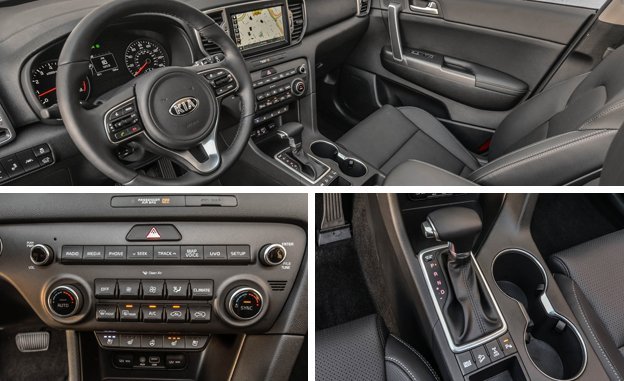

Control functions are easy to identify, and for those who find total touchscreen tyranny oppressive, the display is augmented by a bevy of secondary switches, buttons, and knobs. For its part, the 8.0-inch main screen, which is angled slightly toward the driver, is home to a navigation system that’s more cooperative than many.
A relatively low cowl and thinner A-pillars improve forward sightlines, and the design team pruned the C-pillars, reducing rear-quarter blind spots, although the available blind-spot monitor is still worthwhile. For sun worshippers, there’s a new sunroof whose dimensions rival those of a Great Lakes ore freighter’s main hatch.
Naturally, there are updates on the telematics/infotainment/connectivity front. Topping that list is the availability of Apple CarPlay and Android Auto. Kia also offers the third generation of its UVO system and a Harman/Kardon 320-watt eight-speaker audio system with eight gigabytes of storage.
Safety features basically keep pace with those becoming universal in today’s new vehicles: forward-collision warning and autonomous emergency braking, lane-departure warning (which emits a particularly irritating beep but lacks a lane-keeping component), blind-spot warning, and rear cross-traffic alert.
As noted, the sample vehicles for this preview were all top-of-the-line SX Turbos, either front-drive ($33,395) or equipped with the new Magna-sourced all-wheel-drive system (add $1500). As such, they were essentially all in, feature-wise. Typical of Kia, lesser trims—the naturally aspirated $23,885 LX and $26,395 EX—are well equipped. However, there are extensive options, both packages and stand-alones.
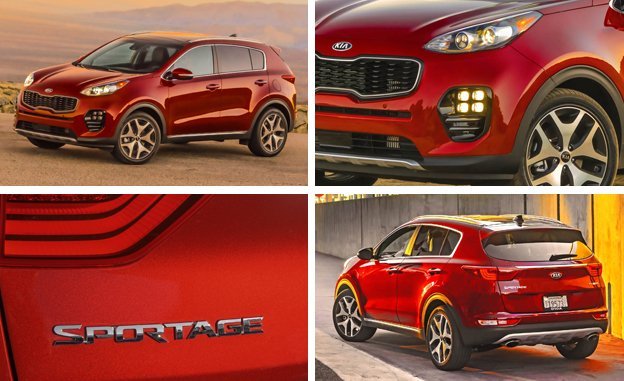

Finally, the styling question. The new front end flirts with the “quirky” label, what with its collection of seemingly disparate styling elements, including the so-called “ice cube” running lights below the headlamps. (We should note that the “cubes” are exclusive to the SX Turbo.)
Kia product planners note that it’s increasingly difficult to stand out in the crowded compact-crossover field, which prompted some liberation from me-too design constraints. And if quirky is the right word, well, Kia has already proved that while it might be a gamble, it’s not necessarily a liability. Consider the boxtastic Soul, Kia’s second-bestselling model.